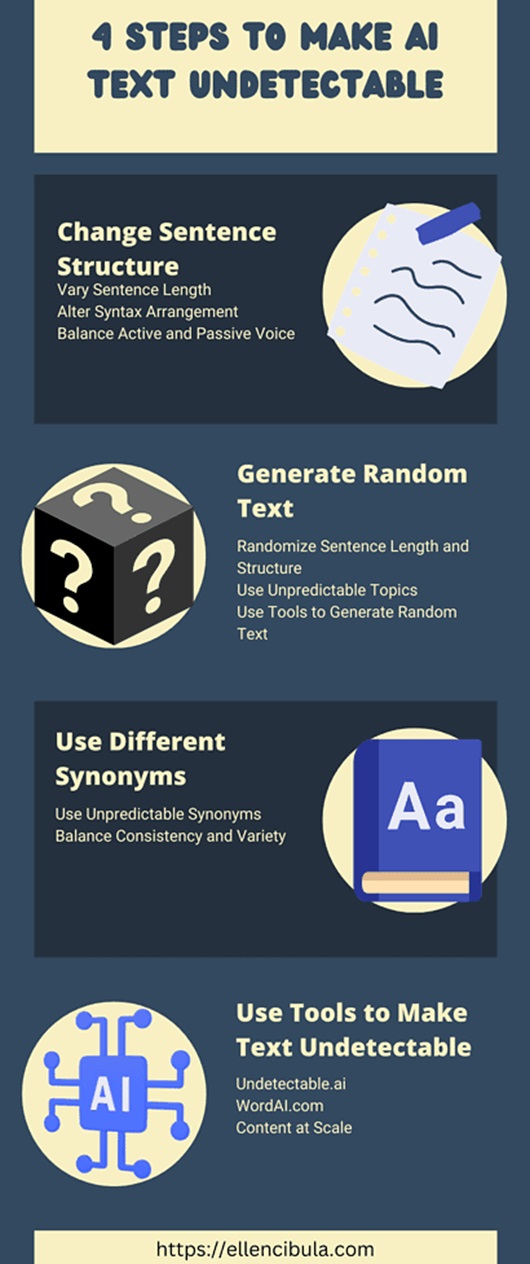Strategies for Living with Undetectable AI Content Proliferation
The relentless march of Artificial Intelligence (AI) has brought us to the precipice of a new era in content creation. AI-powered language models are now capable of generating human-quality text, blurring the lines between machine and human-made content. This proliferation of undetectable AI content presents a unique challenge - how do we navigate a world where information authenticity is increasingly difficult to discern? While some may view undetectable AI content with apprehension, it has the potential to revolutionize various fields. Imagine AI assistants crafting personalized educational materials or generating creative content that caters to individual preferences. However, the ethical implications and potential misuse of undetectable AI content necessitate a proactive approach. This article explores the challenges posed by discrete AI content. It also proposes strategies for mitigating its risks, discusses potential regulatory measures, and the methods used to answer the question of how to make AI-generated text undetectable.
Challenges in Detecting Undetectable AI Content
The very nature of undetectable AI content lies in its ability to mimic human-written text with uncanny accuracy. Traditional methods for identifying machine-generated content, such as analyzing statistical anomalies or stylistic inconsistencies, are becoming increasingly ineffective. Here's a closer look at the roadblocks in detecting undetectable AI content:
- The sophistication of AI-Language Models - modern AI models like GPT-3 are trained on massive datasets of text and code, enabling them to grasp intricate nuances of human language. This allows them to produce content that adheres to grammatical rules, employs proper sentence structure, and even incorporates humor, sarcasm, or other stylistic elements. Additionally, these models continually improve as they process more data, making their output increasingly indistinguishable from human writing and enabling users to make text undetectable by AI According to the article on Medium.com, many AI detection bypassers use sentence alteration, synonym replacement, or incorporating human elements, making them much more discrete for any detector.

Ways that AI text can be made undetectable. Ellen Cibula, “How to Make AI Text Undetectable: 4 Helpful Steps for 2024”, Ellen Cibula, 2023
- Evolving Techniques for Bypassing Detection - researchers constantly strive to develop new techniques that specifically address existing detection methods. This creates a cat-and-mouse game where AI developers continuously refine their models to evade detection algorithms. As a result, the arms race between detection methods and AI content generation techniques escalates, posing a significant challenge to reliably identifying AI-generated content.
- Accessibility of Undetectable AI Content Creation Tools - the availability of undetectable AI paraphrasing tools and AI writer services with undetectable output lowers the barrier to entry for generating deceptive content. Even individuals with limited technical expertise can potentially create and disseminate misleading information by using tools that can paraphrase undetectable AI This democratization of AI content creation amplifies the challenges associated with detecting and combatting the spread of deceptive content online, requiring a multi-faceted approach involving technological, educational, and regulatory interventions.
These challenges highlight the critical need for developing robust strategies to navigate the landscape of undetectable AI content effectively.
Enhancing Critical Thinking Skills in the Face of Undetectable AI Content
In a world saturated with information, equipping ourselves with critical thinking skills is paramount. Here are some strategies to cultivate a discerning eye when encountering online content:
- Source Verification - constantly scrutinize the source of information. Although countless tools can rewrite AI undetectable, they always struggle with processing hard facts and real information. Look for reputable websites, academic journals, or established news organizations with a track record of fact-checking and editorial oversight. Cross-referencing information from multiple credible sources can help validate its accuracy and reliability.
- Triangulation of Information - don't rely on a single source of information. Corroborate the information you encounter with findings from credible websites, scholarly articles, or expert opinions. By triangulating information from multiple independent sources, you can drastically decrease the chance of being hooked by deceptive content.
- Internal Consistency - pay close attention to internal consistency within the content itself. Look for logical fallacies, factual inconsistencies, or claims that seem too good to be true. Critical analysis of the coherence and plausibility of the information presented can reveal signs of potential manipulation or falsehoods.
- Awareness of Bias - be mindful of potential biases, both in yourself and the source of information. Consider the author's background, the website's agenda, and any potential conflicts of interest. Recognizing and accounting for bias can help you evaluate information more objectively and discern its credibility accurately.
- Healthy Skepticism - maintain a healthy dose of skepticism when encountering information, primarily online. Ask yourself critical questions about the purpose of the content, the evidence presented, and the potential motivations behind it. By approaching information with a skeptical mindset, you can guard against falling prey to misinformation or propaganda.
Only by perfecting our critical thinking we can become more adept at discerning between credible and fabricated information, regardless of its source.
Technological Solutions for Mitigating Undetectable AI Content Risks
The main thing mitigating the risks associated with AI-writer undetectable content is the rapid technological growth. Here are some promising avenues for development:
- Advanced Detection Algorithms - researchers are actively developing more sophisticated detection algorithms that can identify undetectable AI content based on subtle linguistic patterns, statistical anomalies, or even the underlying code used to generate the text. By leveraging machine learning and natural language processing techniques, these algorithms can detect patterns indicative of AI content generation and differentiate it from human-authored text more effectively.
- Transparency Mechanisms - encouraging transparency from AI content creators is essential. This could involve implementing mechanisms that flag AI-generated content or provide users with information about the content creation process. By increasing transparency in AI content production, users can make more informed decisions about the information they consume and better assess its credibility.
- Fact-Checking and Verification Tools - investing in the development of robust fact-checking and verification tools can help users assess the accuracy and credibility of online information. These tools can leverage AI algorithms to automatically verify claims, identify misinformation, and provide users with relevant context and evidence to evaluate the reliability of the information presented.
- Collaborative Efforts - collaboration between researchers, developers, and policymakers is crucial for staying ahead of the curve and developing comprehensive solutions to address the challenges posed by undetectable AI content. By fostering interdisciplinary collaboration and knowledge-sharing, stakeholders can leverage collective expertise to develop more effective strategies for detecting and mitigating the spread of deceptive content online.
Regulatory Measures to Safeguard Against Undetectable AI Content
Regulation can play a vital role in safeguarding against the misuse of undetectable AI content. Here are some potential regulatory measures to consider:
- Disclosure Requirements - implementing regulations that mandate disclosure of AI-generated content can promote transparency and empower users to make informed decisions about the information they consume. By requiring content creators to disclose when AI technologies are used in content generation, users can better assess the reliability and authenticity of the information presented.
- Prohibition of Malicious Use - establishing clear legal boundaries against the malicious use of undetectable AI content, such as spreading misinformation or creating deepfakes for fraudulent purposes, is essential for protecting individuals and society from harm. By prohibiting the dissemination of deceptive or harmful AI-generated content, regulators can deter bad actors from exploiting AI technologies for malicious purposes and mitigate the societal impact of misinformation.
- Standardization of AI Content Labeling - developing standardized labels or indicators to identify AI-generated content can raise user awareness and encourage responsible use of the technology. By implementing clear labeling standards for AI-generated content, users can easily distinguish between human-authored and AI-generated text, enabling them to make more informed decisions about the information they encounter online. In this case, even tools that make text undetectable by AI indicators won’t be used for evil purposes.
- Education and Public Awareness Campaigns - educating the public about the potential pitfalls of undetectable AI content and equipping them with the necessary skills to discern credible information is crucial. By raising awareness about the prevalence of AI-generated content and providing guidance on how to critically evaluate online information, education, and public awareness campaigns can empower individuals to navigate the digital landscape more effectively and resist manipulation by deceptive content.
- International Cooperation - the issue of undetectable AI content transcends geographical boundaries. International cooperation among policymakers and regulatory bodies is essential for establishing a comprehensive framework to address this challenge. By fostering collaboration at the international level, countries can share best practices, harmonize regulatory approaches, and coordinate efforts to combat the spread of undetectable AI content across borders.
Moreover, international collaboration can facilitate information sharing and joint research initiatives aimed at advancing detection technologies and developing standardized solutions for addressing the proliferation of AI-generated content. By pooling resources and expertise on a global scale, stakeholders can more effectively address the multifaceted challenges posed by undetectable AI content and safeguard the integrity of online information ecosystems. Although there are numerous services like GPTinf (https://www.gptinf.com/undetectable-ai) that paraphrase undetectable AI text, making it suitable for various purposes, the issue of AI content abuse still stands critical.
In addition to regulatory measures, fostering a culture of responsible AI use and ethical content creation is essential for mitigating the risks associated with undetectable AI content. This involves promoting transparency, accountability, and ethical standards among AI developers, content creators, and platform providers. By adhering to ethical guidelines and best practices, stakeholders can help build trust in AI technologies and minimize potential misuse or abuse.
Furthermore, empowering users with tools and resources to identify and combat deceptive content is crucial for enhancing resilience against the proliferation of undetectable AI content. This includes investing in media literacy programs, developing user-friendly fact-checking tools, and promoting digital literacy initiatives that equip individuals with the skills and knowledge to critically evaluate information online. By empowering users to become more discerning consumers of digital content, society can collectively mitigate the impact of misleading or harmful AI-generated content.

